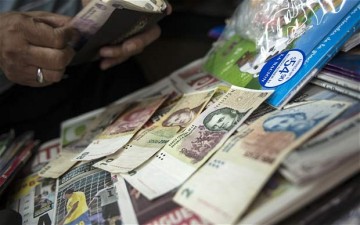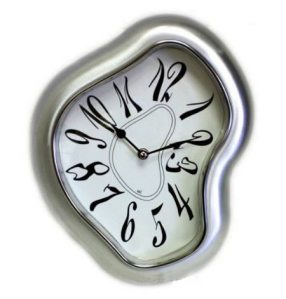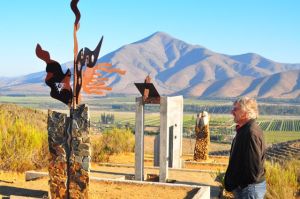When imagining “cool climate” wines, what springs to my mind first is the image of soggy, wet vines and miserable days of drizzle that leave your head firmly in the clouds — and not in a good way. Spending the first 25 years of my life in England probably didn’t help that image.
 But in Chile, as I sat lapping up the sunshine by a glistening swimming pool under perfect blue skies, listening to birds squawk in the palm trees of Matetic winery’s boutique hotel in Casablanca/San Antonio, I started to question my initial impressions of cool climate. It wasn’t cold here. In fact, it was positively balmy.
But in Chile, as I sat lapping up the sunshine by a glistening swimming pool under perfect blue skies, listening to birds squawk in the palm trees of Matetic winery’s boutique hotel in Casablanca/San Antonio, I started to question my initial impressions of cool climate. It wasn’t cold here. In fact, it was positively balmy.
Casablanca might be a cool climate wine region, but visiting the area is not a frosty experience: days are filled with sunshine and warm lazy afternoons drinking copious amounts of wine as you tuck into fine Chilean cuisine. On this particular afternoon I was tucking into fresh and buttery potted crab with a glass of tropical fruit-filled Chardonnay, followed by a rosemary-crusted lamb fillet with a smooth, spicy Syrah. I couldn’t keep my top button done up, let alone keep my jacket on.
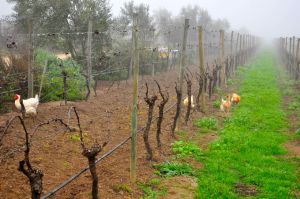 While the day time temperatures and sunny climes make Casablanca a perfect holiday destination, the cooler nights mean you won’t lose any hours of sleep and can still rest nicely with a big blanket — which is good news for both people and grapes. The big difference in temperature from the sunny, skin ripening days compared to the crisp nights is what makes these wines so racy. And in the morning when you do finally wake from a perfect slumber, a fresh fog lays over the valley keeping the grapes cool and not awakening them too rudely either. The sun slowly appears through the fog, and then we are back to sunbathing. I understand why grapes do so well here: they can rest at night, and get some color during the day. And that is the secret to the success of cool climate wines … maintaining the cool acidity while developing their color, sugar and flavor profiles in the summery afternoons.
While the day time temperatures and sunny climes make Casablanca a perfect holiday destination, the cooler nights mean you won’t lose any hours of sleep and can still rest nicely with a big blanket — which is good news for both people and grapes. The big difference in temperature from the sunny, skin ripening days compared to the crisp nights is what makes these wines so racy. And in the morning when you do finally wake from a perfect slumber, a fresh fog lays over the valley keeping the grapes cool and not awakening them too rudely either. The sun slowly appears through the fog, and then we are back to sunbathing. I understand why grapes do so well here: they can rest at night, and get some color during the day. And that is the secret to the success of cool climate wines … maintaining the cool acidity while developing their color, sugar and flavor profiles in the summery afternoons.
Continue reading “Keeping Cool in Casablanca”






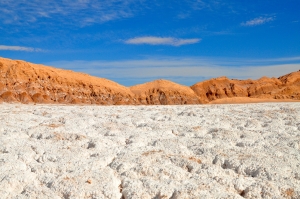


 While the day time temperatures and sunny climes make Casablanca a perfect holiday destination, the cooler nights mean you won’t lose any hours of sleep and can still rest nicely with a big blanket — which is good news for both people and grapes. The big difference in temperature from the sunny, skin ripening days compared to the crisp nights is what makes these wines so racy. And in the morning when you do finally wake from a perfect slumber, a fresh fog lays over the valley keeping the grapes cool and not awakening them too rudely either. The sun slowly appears through the fog, and then we are back to sunbathing. I understand why grapes do so well here: they can rest at night, and get some color during the day. And that is the secret to the success of cool climate wines … maintaining the cool acidity while developing their color, sugar and flavor profiles in the summery afternoons.
While the day time temperatures and sunny climes make Casablanca a perfect holiday destination, the cooler nights mean you won’t lose any hours of sleep and can still rest nicely with a big blanket — which is good news for both people and grapes. The big difference in temperature from the sunny, skin ripening days compared to the crisp nights is what makes these wines so racy. And in the morning when you do finally wake from a perfect slumber, a fresh fog lays over the valley keeping the grapes cool and not awakening them too rudely either. The sun slowly appears through the fog, and then we are back to sunbathing. I understand why grapes do so well here: they can rest at night, and get some color during the day. And that is the secret to the success of cool climate wines … maintaining the cool acidity while developing their color, sugar and flavor profiles in the summery afternoons.